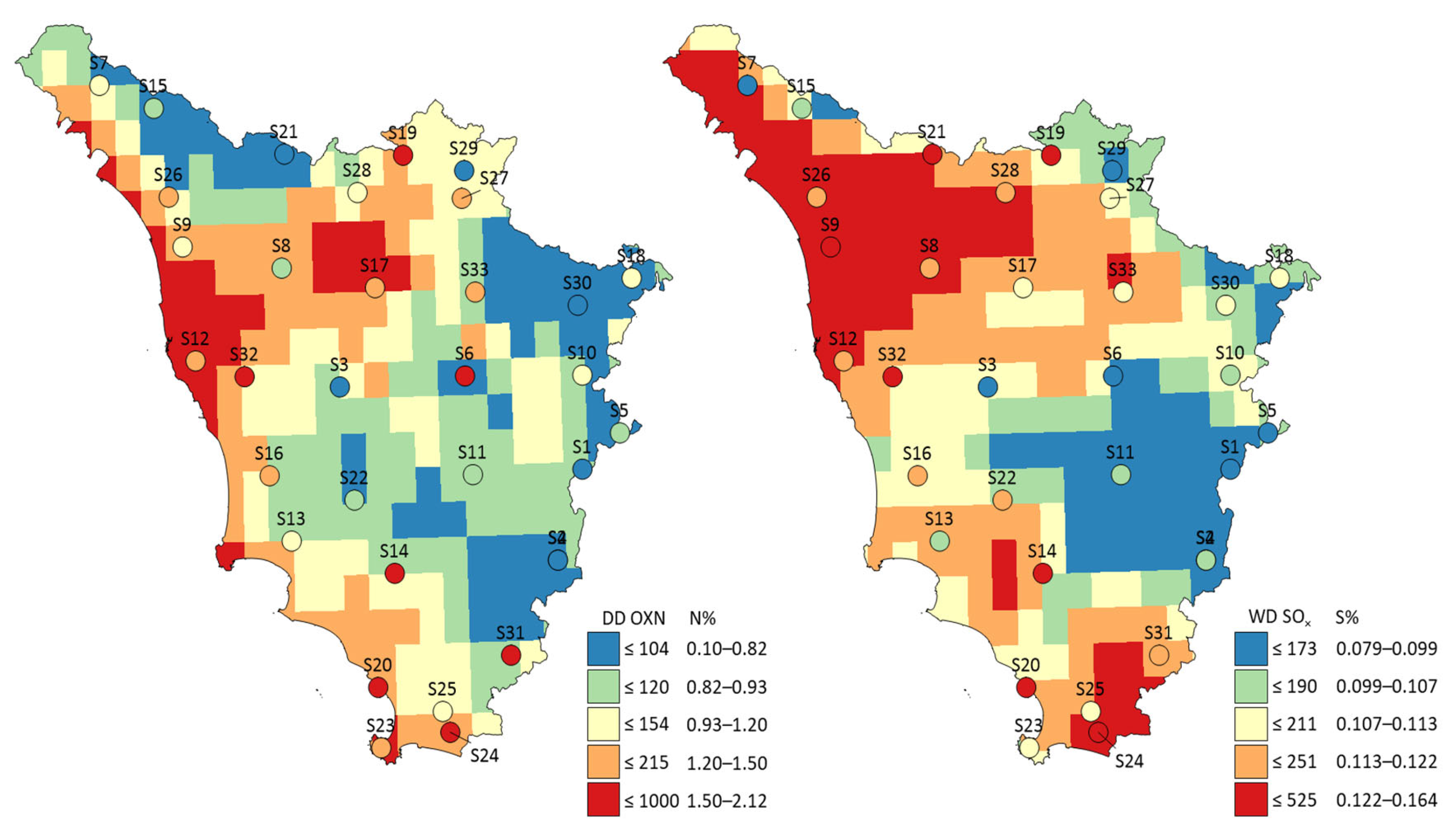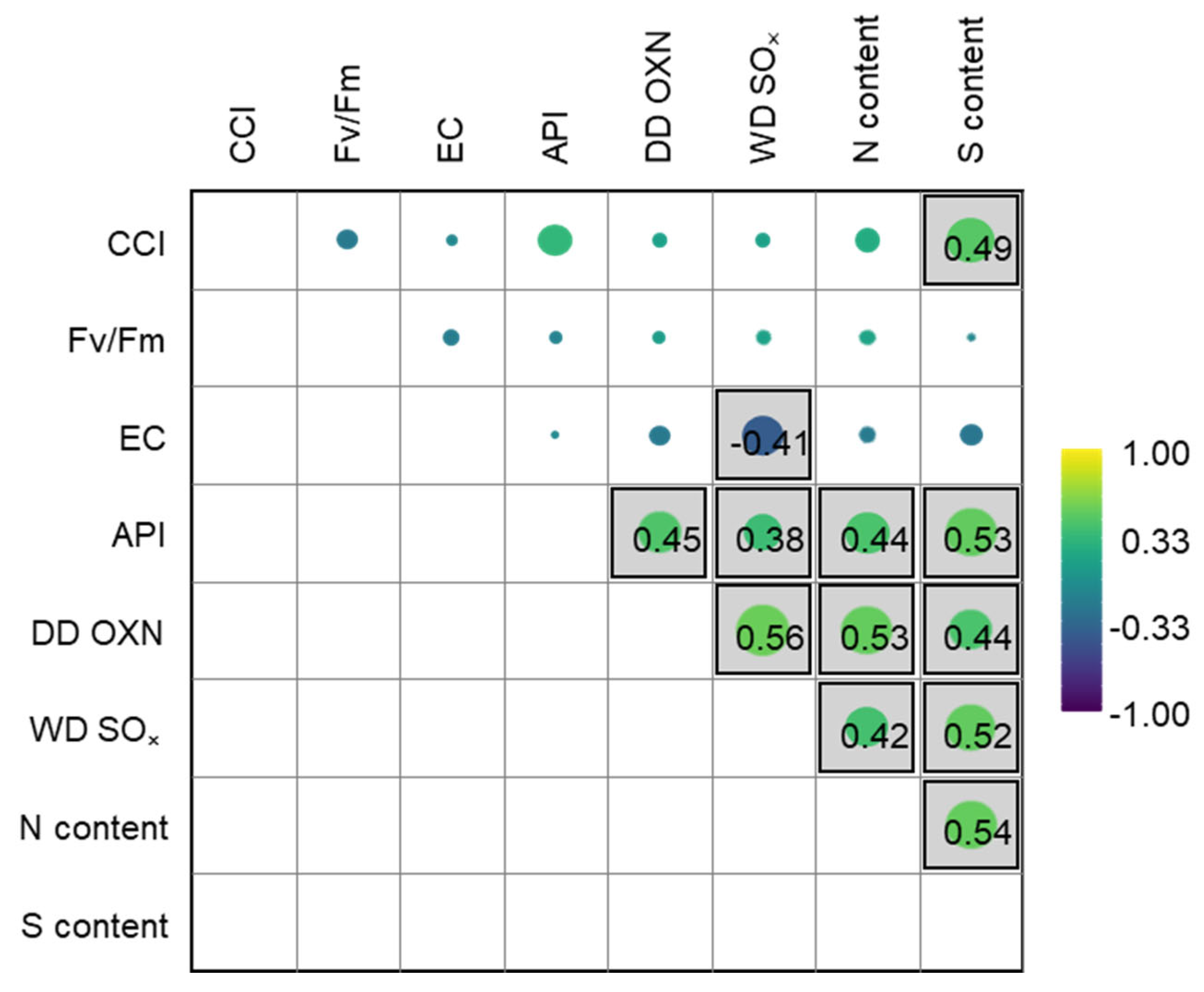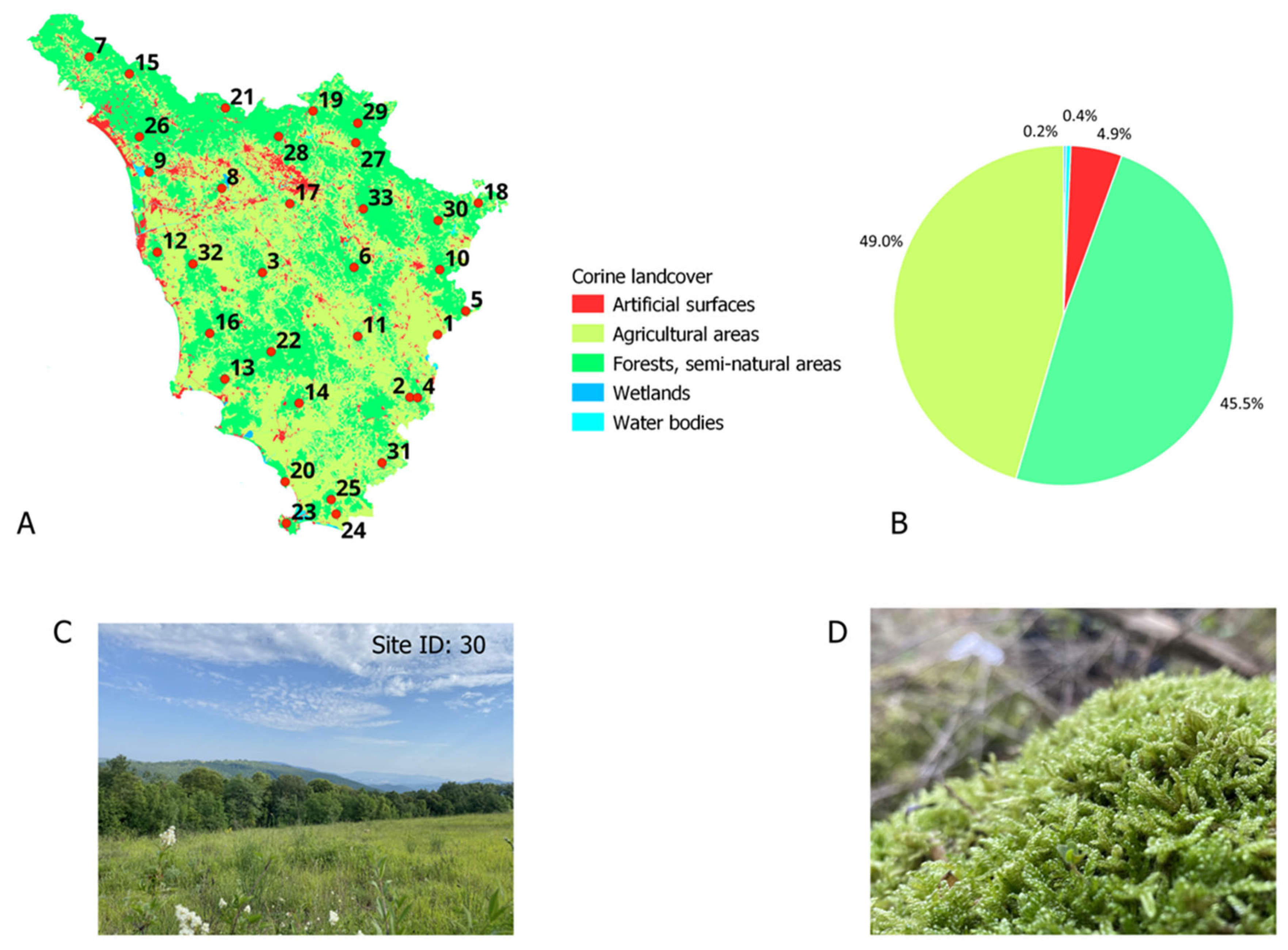Is Moss Still a Reliable Biomonitor of Nitrogen and Sulfur Deposition After Decades of Emissions Reductions?
Abstract
:1. Introduction
2. Results
3. Discussion
4. Materials and Methods
4.1. Study Area and Sampling Sites
4.2. Moss Sampling
4.3. Nitrogen and Sulfur Analysis
4.4. Sample Vitality
4.5. Data Analysis
Supplementary Materials
Author Contributions
Funding
Data Availability Statement
Acknowledgments
Conflicts of Interest
References
- Grennfelt, P.; Engleryd, A.; Forsius MHov, Ø.; Rodhe, H.; Cowling, E. Acid rain and air pollution: 50 years of progress in environmental science and policy. Ambio 2020, 49, 849–864. [Google Scholar] [PubMed]
- Aas, W.; Fagerli, H.; Alastuey, A.; Cavalli, F.; Degorska, A.; Feigenspan, S.; Brenna, H.; Gliß, J.; Heinesen, D.; Hueglin, C.; et al. Trends in Air Pollution in Europe, 2000–2019. Aerosol Air Qual. Res. 2024, 24, 230237. [Google Scholar] [CrossRef]
- Erisman, J.W.; Grennfelt, P.; Sutton, M. The European perspective on nitrogen emission and deposition. Environ. Int. 2003, 29, 311–325. [Google Scholar]
- Vestreng, V.; Myhre, G.; Fagerli, H.; Reis, S.; Tarrasón, L. Twenty-five years of continuous sulphur dioxide emission reduction in Europe. Atmos. Chem. Phys. 2007, 7, 3663–3681. [Google Scholar] [CrossRef]
- Seaton, F.M.; Robinson, D.A.; Monteith, D.; Lebron, I.; Bürkner, P.; Tomlinson, S.; Emmett, B.A.; Smart, S.M. Fifty years of reduction in sulphur deposition drives recovery in soil pH and plant communities. J. Ecol. 2023, 111, 464–478. [Google Scholar]
- Wright, R.F.; Larssen, T.; Camarero, L.; Cosby, B.J.; Ferrier, R.C.; Helliwell, R.; Forsius, M.; Jenkins, A.; Kopáěek, J.; Majer, V.; et al. Recovery of acidified European surface waters. Environ. Sci. Technol. 2005, 39, 64A–72A. [Google Scholar] [CrossRef]
- Tørseth, K.; Aas, W.; Breivik, K.; Fjæraa, A.M.; Fiebig, M.; Hjellbrekke, A.G.; Lund Myhre, C.; Solberg, S.; Yttri, K.E. Introduction to the European Monitoring and Evaluation Programme (EMEP) and observed atmospheric composition change during 1972–2009. Atmos. Chem. Phys. 2012, 12, 5447–5481. [Google Scholar] [CrossRef]
- Vet, R.; Artz, R.S.; Carou, S.; Shaw, M.; Ro, C.U.; Aas, W.; Baker, A.; Bowersox, V.C.; Dentener, F.; Galy-Lacaux, C.; et al. A global assessment of precipitation chemistry and deposition of sulfur, nitrogen, sea salt, base cations, organic acids, acidity and pH, and phosphorus. Atmos. Environ. 2014, 93, 3–100. [Google Scholar] [CrossRef]
- Simpson, D.; Benedictow, A.; Berge, H.; Bergström, R.; Emberson, L.D.; Fagerli, H.; Flechard, C.R.; Hayman, G.D.; Gauss, M.; Jonson, J.E.; et al. The EMEP MSC-W chemical transport model—Technical description. Atmos. Chem. Phys. 2012, 12, 7825–7865. [Google Scholar] [CrossRef]
- Marchetto, A.; Simpson, D.; Aas, W.; Fagerli, H.; Hansen, K.; Pihl-Karlsson, G.; Karlsson, P.E.; Rogora, M.; Sanders, T.G.; Schmitz, A.; et al. Good agreement between modeled and measured sulfur and nitrogen deposition in Europe, in spite of marked differences in some sites. Front. Environ. Sci. 2021, 9, 734556. [Google Scholar] [CrossRef]
- Rühling, A.; Tyler, G. Sorption and retention of heavy metals in the woodland moss Hylocomium splendens (Hedw). Oikos 1970, 21, 92–97. [Google Scholar] [CrossRef]
- Berg, T.; Røyset, O.; Steinnes, E. Moss (Hylocomium splendens) used as a biomonitor of atmospheric trace-element deposition—Estimation of uptake efficiencies. Atmos. Environ. 1995, 29, 353–360. [Google Scholar] [CrossRef]
- Salemaa, M.; Derome, J.; Helmisaari, H.S.; Nieminen, T.; Vanha-Majamaa, I. Element accumulation in boreal bryophytes, lichens and vascular plants exposed to heavy metal and sulfur deposition in Finland. Sci. Total Environ. 2004, 324, 141–160. [Google Scholar] [CrossRef] [PubMed]
- Harmens, H.; Norris, D.A.; Cooper, D.M.; Mills, G.; Steinnes, E.; Kubin, E.; Thöni, L.; Aboal, J.R.; Alber, R.; Carballeira, A.; et al. Nitrogen concentrations in mosses indicate the spatial distribution of atmospheric nitrogen deposition in Europe. Environ. Pollut. 2011, 159, 2852–2860. [Google Scholar] [CrossRef]
- Schröder, W.; Pesch, R.; Schönrock, S.; Harmens, H.; Mills, G.; Fagerli, H. Mapping correlations between nitrogen concentrations in atmospheric deposition and mosses for natural landscapes in Europe. Ecol. Indic. 2014, 36, 563–571. [Google Scholar] [CrossRef]
- Olmstead, E.; Aherne, J. Are tissue concentrations of Hylocomium splendens a good predictor of nitrogen deposition? Atmos. Pollut. Res. 2019, 10, 80–87. [Google Scholar] [CrossRef]
- Berg, T.; Røyset, O.; Steinnes, E.; Vadset, M. Atmospheric trace element deposition: Principal component analysis of ICP-MS data from moss samples. Environ. Pollut. 1995, 88, 67–77. [Google Scholar] [CrossRef]
- Loppi, S.; Bonini, I. Lichens and mosses as biomonitors of trace elements in areas with thermal springs and fumarole activity (Mt. Amiata, central Italy). Chemosphere 2000, 41, 1333–1336. [Google Scholar] [CrossRef]
- Adamo, P.; Giordano, S.; Vingiani, S.; Cobianchi, R.C.; Violante, P. Trace element accumulation by moss and lichen exposed in bags in the city of Naples (Italy). Environ. Pollut. 2003, 122, 91–103. [Google Scholar] [CrossRef]
- Roblin, B.; Aherne, J. Moss as a biomonitor for the atmospheric deposition of anthropogenic microfibres. Sci. Total Environ. 2020, 715, 136973. [Google Scholar] [CrossRef]
- Jafarova, M.; Grifoni, L.; Aherne, J.; Loppi, S. Comparison of lichens and mosses as biomonitors of airborne microplastics. Atmosphere 2023, 14, 1007. [Google Scholar] [CrossRef]
- Jafarova, M. Assessing the Deposition of Airborne Microplastics Using Vegetation. Doctoral Thesis, Università degli Studi di Siena, Siena, Italy, 2024; p. 96. [Google Scholar] [CrossRef]
- Aničić, M.; Tomašević, M.; Tasić, M.; Rajšić, S.; Popović, A.; Frontasyeva, M.V.; Lierhagen, S.; Steinnes, E. Monitoring of trace element atmospheric deposition using dry and wet moss bags: Accumulation capacity versus exposure time. J. Hazard. Mater. 2009, 171, 182–188. [Google Scholar] [PubMed]
- Capozzi, F.; Giordano, S.; Aboal, J.R.; Adamo, P.; Bargagli, R.; Boquete, T.; Di Palma, A.; Real, C.; Reski, R.; Spagnuolo, V.; et al. Best options for the exposure of traditional and innovative moss bags: A systematic evaluation in three European countries. Environ. Pollut. 2016, 214, 362–373. [Google Scholar] [CrossRef]
- Jafarova, M.; Zinicovscaia, I.; Yushin NBonini, I.; Winkler, A.; Loppi, S. Biomonitoring of atmospheric deposition of potentially toxic elements at rural sites in Tuscany (Central Italy). Arch. Environ. Contam. Toxicol. 2025, 88, 29–38. [Google Scholar]
- Spagnuolo, V.; Zampella, M.; Giordano, S.; Adamo, P. Cytological stress and element uptake in moss and lichen exposed in bags in urban area. Ecotoxicol. Environ. Saf. 2011, 74, 1434–1443. [Google Scholar]
- Szarek, G.; Chrzanowska, E. The total sulphur content in the mosses of Polish National Parks-changes within the last 10 years. Acta Soc. Bot. Pol. 1991, 60, 101–110. [Google Scholar] [CrossRef]
- Nriagu, J.O.; Glooschenko, W.A. Isotopic composition of sulfur in mosses across Canada. Environ. Sci. Technol. 1992, 26, 85–89. [Google Scholar]
- Raymond, B.A.; Bassingthwaighte, T.; Patrick, D.S. Measuring nitrogen and sulphur deposition in the Georgia Basin, British Columbia, using lichens and moss. J. Limnol. 2010, 69, 22. [Google Scholar]
- Rogora, M.; Colombo, L.; Marchetto, A.; Mosello, R.; Steingruber, S. Temporal and spatial patterns in the chemistry of wet deposition in Southern Alps. Atmos. Environ. 2016, 146, 44–54. [Google Scholar]
- Pitcairn, C.E.R.; Fowler, D.; Grace, J. Deposition of fixed atmospheric nitrogen and foliar nitrogen content of bryophytes and Calluna vulgaris (L.) Hull. Environ. Pollut. 1995, 99, 193–205. [Google Scholar]
- Solga, A.; Burkhardt, J.; Zechmeister, H.G.; Frahm, J.-P. Nitrogen content, 15N natural abundance and biomass of the two pleurocarpous mosses Pleurozium schreberi (Brid.) Mitt., and Scleropodium purum (Hedw.) Limpr. In relation to atmospheric nitrogen deposition. Environ. Pollut. 2005, 134, 465–473. [Google Scholar] [PubMed]
- Xiao, H.Y.; Tang, C.G.; Xiao, H.W.; Wang, Y.L.; Liu, X.Y.; Liu, C.Q. Tissue S/N ratios and stable isotopes (δ34S and δ15N) of epilithic mosses (Haplocladium microphyllum) for showing air pollution in urban cities in Southern China. Environ. Pollut. 2010, 158, 1726–1732. [Google Scholar] [PubMed]
- Harmens, H.; Foan, L.; Simon, V.; Mills, G. Terrestrial mosses as biomonitors of atmospheric POPs pollution: A review. Environ. Pollut. 2013, 173, 245–254. [Google Scholar]
- Harmens, H.; Norris, D.A.; Sharps, K.; Mills, G.; Alber, R.; Aleksiayenak, Y.; Blum, O.; Cucu-Man, S.-M.; Dam, M.; De Temmerman, L.; et al. Heavy metal and nitrogen concentrations in mosses are declining across Europe whilst some “hotspots” remain in 2010. Environ. Pollut. 2015, 200, 93–104. [Google Scholar]
- Schröder, W.; Holy, M.; Pesch, R.; Harmens, H.; Fagerli, H.; Alber, R.; Coşkun, M.; De Temmerman, L.; Frolova, M.; González-Miqueo, L.; et al. First Europe-wide correlation analysis identifying factors best explaining the total nitrogen concentration in mosses. Atmos. Environ. 2010, 44, 3485–3491. [Google Scholar]
- Pitcairn, C.; Fowler, D.; Leith, I.; Sheppard, L.; Tang, S.; Sutton, M.; Famulari, D. Diagnostic indicators of elevated nitrogen deposition. Environ. Pollut. 2006, 144, 941–950. [Google Scholar]
- Fritz, C.; Lamers, L.P.; Riaz, M.; van den Berg, L.J.; Elzenga, T.J. Sphagnum mosses-masters of efficient N-uptake while avoiding intoxication. PLoS ONE 2014, 9, e79991. [Google Scholar]
- Terry, N. Effects of sulfur on the photosynthesis of intact leaves and isolated chloroplasts of sugar beets. Plant Physiol. 1976, 57, 477–479. [Google Scholar] [CrossRef]
- Tretiach, M.; Adamo, P.; Bargagli, R.; Baruffo, L.; Carletti, L.; Crisafulli, P.A.O.L.A.; Giordano, S.; Modenesi, P.; Orlando, S.; Pittao, E.L.E.N.A. Lichen and moss bags as monitoring devices in urban areas. Part I: Influence of exposure on sample vitality. Environ. Pollut. 2007, 146, 380–391. [Google Scholar]
- ICP Vegetation Monitoring Manual, 2020. Heavy Metals, Nitrogen and Pops in European Mosses: 2020 Survey. Available online: https://icpvegetation.ceh.ac.uk/get-involved/manuals/moss-survey (accessed on 28 August 2024).
- Zinicovscaia, I.; Hramco, C.; Chaligava, O.; Yushin, N.; Grozdov, D.; Vergel, K.; Duca, G. Accumulation of potentially toxic elements in mosses collected in the Republic of Moldova. Plants 2021, 10, 471. [Google Scholar] [CrossRef]
- Vannini, A.; Paoli, L.; Nicolardi, V.; Di Lella, L.A.; Loppi, S. Seasonal variations in intracellular trace element content and physiological parameters in the lichen Evernia prunastri transplanted to an urban environment. Acta Bot. Croat. 2017, 76, 171–176. [Google Scholar]
- Capozzi, F.; Sorrentino, M.C.; Di Palma, A.; Mele, F.; Arena, C.; Adamo, P.; Spagnuolo, V.; Giordano, S. Implication of vitality, seasonality and specific leaf area on PAH uptake in moss and lichen transplanted in bags. Ecol. Indic. 2020, 108, 105727. [Google Scholar]
- Grifoni, L.; Jafarova, M.; La Colla, N.S.; Aherne, J.; Raulli, A.; Loppi, S. Comparison of Lichen and Moss Transplants for Monitoring the Deposition of Airborne Microfibers. Sustainability 2025, 17, 537. [Google Scholar] [CrossRef]
- European Environment Agency. EMEP/EEA Air Pollutant Emission Inventory Guidebook 2023—Technical Guidance to Prepare National Emission Inventories; Publications Office of the European Union: Luxembourg, 2023; Available online: https://data.europa.eu/doi/10.2800/795737 (accessed on 29 March 2025).
- R Core Team. R: A Language and Environment for Statistical Computing; R Foundation for Statistical Computing: Vienna, Austria, 2024; Available online: https://www.R-project.org/ (accessed on 19 October 2024).
- Hammer, Ø.; Harper, D.A.T.; Ryan, P.D. PAST: Paleontological Statistics Software Package for Education and Data Analysis. Palaeontol. Electron. 2001, 4, 9. [Google Scholar]




| Variable | Mean ± Std | Median | Min. | Max. | CV (%) |
|---|---|---|---|---|---|
| N content (%) | 1.15 ± 0.42 | 1.11 | 0.10 | 2.12 | 36.5 |
| S content (%) | 0.11 ± 0.02 | 0.11 | 0.08 | 0.16 | 17.4 |
| N content (mg/m2) | 84.9 ± 31.0 | 82.2 | 7.7 | 157.0 | 36.5 |
| S content (mg/m2) | 8.4 ± 1.5 | 8.2 | 5.8 | 12.2 | 17.4 |
| N Deposition (mg/m2) | 822 ± 151 | 789 | 651 | 1205 | 18.3 |
| OXN Deposition (mg/m2) | 406 ± 116 | 380 | 270 | 699 | 28.5 |
| S Deposition (mg/m2) | 214 ± 66 | 203 | 142 | 423 | 31.0 |
| N content: Deposition | 0.10 ± 0.04 | 0.10 | 0.01 | 0.19 | 38.3 |
| S content: Deposition | 0.04 ± 0.01 | 0.04 | 0.02 | 0.06 | 24.6 |
| CCI (mg/m2) | 438 ± 42 | 444 | 325 | 523 | 9.6 |
| Fv/Fm | 0.66 ± 0.03 | 0.66 | 0.58 | 0.74 | 4.8 |
| EC (%) | 10.5 ± 3.79 | 9.47 | 5.37 | 25.3 | 36.0 |
Disclaimer/Publisher’s Note: The statements, opinions and data contained in all publications are solely those of the individual author(s) and contributor(s) and not of MDPI and/or the editor(s). MDPI and/or the editor(s) disclaim responsibility for any injury to people or property resulting from any ideas, methods, instructions or products referred to in the content. |
© 2025 by the authors. Licensee MDPI, Basel, Switzerland. This article is an open access article distributed under the terms and conditions of the Creative Commons Attribution (CC BY) license (https://creativecommons.org/licenses/by/4.0/).
Share and Cite
Jafarova, M.; Aherne, J.; Renzi, M.; Anselmi, S.; Zinicovscaia, I.; Yushin, N.; Bonini, I.; Loppi, S. Is Moss Still a Reliable Biomonitor of Nitrogen and Sulfur Deposition After Decades of Emissions Reductions? Plants 2025, 14, 1114. https://doi.org/10.3390/plants14071114
Jafarova M, Aherne J, Renzi M, Anselmi S, Zinicovscaia I, Yushin N, Bonini I, Loppi S. Is Moss Still a Reliable Biomonitor of Nitrogen and Sulfur Deposition After Decades of Emissions Reductions? Plants. 2025; 14(7):1114. https://doi.org/10.3390/plants14071114
Chicago/Turabian StyleJafarova, Mehriban, Julian Aherne, Monia Renzi, Serena Anselmi, Inga Zinicovscaia, Nikita Yushin, Ilaria Bonini, and Stefano Loppi. 2025. "Is Moss Still a Reliable Biomonitor of Nitrogen and Sulfur Deposition After Decades of Emissions Reductions?" Plants 14, no. 7: 1114. https://doi.org/10.3390/plants14071114
APA StyleJafarova, M., Aherne, J., Renzi, M., Anselmi, S., Zinicovscaia, I., Yushin, N., Bonini, I., & Loppi, S. (2025). Is Moss Still a Reliable Biomonitor of Nitrogen and Sulfur Deposition After Decades of Emissions Reductions? Plants, 14(7), 1114. https://doi.org/10.3390/plants14071114











